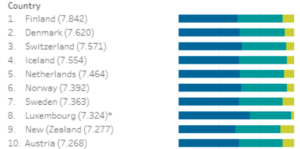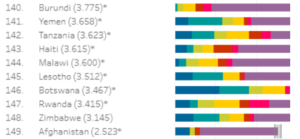In news: India ranked 139th in the recently released World Happiness Report 2021
About the World Happiness Report 2021
- Released by: Sustainable Development Solutions Network for the United Nations
- Edition: Ninth
- This year’s theme of the report:
- This year’s report focuses on the effects of COVID-19 on happiness and how countries have differed in their success in reducing the deaths and maintaining connected and healthy societies.
- The effects of the pandemic on happiness, mental health, social connections, and the workplace are covered in some chapters of the report
- The report ranks 149 countries on “how happy their citizens perceive themselves to be”.
- The results of the report, which is based on the Gallup World Poll, have been correlated with factors like GDP and social security.
- Base year: Ranking of Happiness based on a three-year-average 2018-2020.
Key findings of the report
- World: Finland has been declared the world’s happiest country for the fourth year running, according to the World Happiness Report 2021. Of the 10 top countries in the list, nine were in Europe
- As per the report, trust was the key factor used to measure happiness in each country. Nations where citizens had more faith vested in its institutions and had greater income equality were considered to be more successful in combating the pandemic.
- A number of Asian countries fared better this year than they had last year, while China moved to the 84th spot from the 94th.
- India: The report ranked India 139th out of 149 countries, this India improved this year as compared to previous year(rank 144)
Top ten ranking countries

Bottom ten ranking countries

Factors measured
- The report evaluated levels of happiness by taking into account factors such as GDP, social support, personal freedom, and levels of corruption in each nation.
- But this year, the authors had a unique new challenge to address in the report the ongoing Covid-19 pandemic and its devastating impact on nations around the world.
- While measuring the report uses the term ‘Dystopia’ which is an imaginary country that has the world’s least-happy people.
- The purpose in establishing Dystopia is to have a benchmark against which all countries can be favorably compared (no country performs more poorly than Dystopia) in terms of each of the six key variables, thus allowing each sub-bar to be of positive (or zero, in six instances) width
- The lowest scores observed for the six key variables, therefore, characterize Dystopia.
UN Sustainable Development Solutions Network(SDSN)
- The UN SDSN was set up in 2012 under the auspices of the UN Secretary-General.
- SDSN mobilizes global scientific and technological expertise to promote practical solutions for sustainable development, including the implementation of the Sustainable Development Goals (SDGs) and the Paris Climate Agreement.
- SDSN works closely with United Nations agencies, multilateral financing institutions, the private sector, and civil society.
- SDSN is guided by a Leadership Council, which brings together global sustainable development leaders from all regions and all sectors, including civil society, public, and private sectors.
- The Leadership Council acts as the board of SDSN. Much of SDSN’s work is led by National or Regional SDSNs, which mobilize knowledge institutions around the SDGs.
- Its research & policy work mobilizes experts from around the world on the technical challenges of implementing the SDGs and the Paris Climate Agreement.
- The SDG Academy leads the education work of the SDSN.
- SDSN Secretariat: Until 2016, the SDSN Secretariat was hosted by the Earth Institute at Columbia University. Since July 2016, the SDSN Secretariat and the SDG Academy have been hosted by the SDSN Association, a 501 (c) (3) non-profit organization.
- SDSN has offices in New York, Paris, and Kuala Lumpur.
















